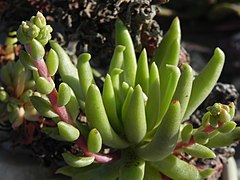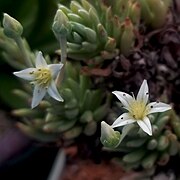
Dudleya, commonly known as liveforevers, is a genus of rosette-forming succulent plants in the stonecrop family, Crassulaceae, consisting of about 68 taxa in southwestern North America and Guadalupe Island. The species come in many forms, some large and evergreen, others geophytic and deciduous. Yet, despite their dramatic variations in appearance, most species readily hybridize. The flowers of Dudleya have parts numbered in fives, with the petals arranged in tubular, star-shaped, and bell-shaped forms and, when fruiting, are filled with tiny, ovoid-crescent-shaped seeds.

Dudleya blochmaniae is a summer-deciduous succulent plant known by the common names Blochman's liveforever or Blochman's dudleya. This species of Dudleya survives part of the year with no aboveground presence, surviving as underground corm-like roots in deciduous months. It is characterized by white, star-shaped and spreading flowers that emerge after sufficient rainfall. It is found along the Pacific coast of the California Floristic Province, from the vicinity of San Luis Obispo in California to Punta Colonet in Baja California.

Dudleya caespitosa is a succulent plant known by several common names, including sea lettuce, sand lettuce, and coast dudleya. It is endemic to California, where it grows along the coastline in the southern half of the state. Taxonomically, this species is a highly variable complex of polymorphic and polyploid plants, closely related to numerous neighboring species such as Dudleya farinosa, Dudleya greenei and Dudleya palmeri. It is delimited from neighboring species on an arbitrary basis of distribution and chromosome number, and may not be immediately separable from the other species it approaches.

Dudleya lanceolata is a succulent plant known by the common name lanceleaf liveforever or lance-leaved dudleya. It is an extremely variable and widely ranging species that occurs from Monterey County and Kern County in California south through Ensenada in Baja California. It is characterized by green to purple lanceolate leaves, red, orange, or less commonly yellow petals, and is typically tetraploid. Despite its diversity, it is quite stable as a species, but hybrids may be discovered with other species of Dudleya, which can make it difficult to discern in areas where numerous species converge.

Dudleya multicaulis is a succulent plant known by the common name manystem liveforever or many-stemmed dudleya. This Dudleya is endemic to southern California, where it is rare and seriously threatened as its habitat is altered by humans. Many occurrences of this species have been extirpated. This species is characterized by a few short, fingerlike cylindrical leaves with pointed tips, and its erect peduncle, which is topped with a branching inflorescence bearing up to 15 flowers on each long, thin branch. The flowers, which appear in late spring, have pointed yellow petals and long stamens. It is usually found on heavy clay or rocky soils and outcrops.
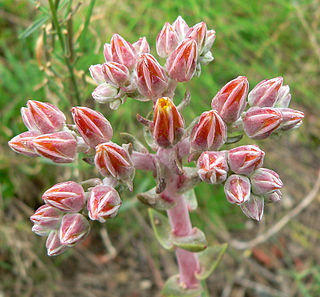
Dudleya palmeri is a species of succulent plant in the family Crassulaceae known by the common name Palmer's liveforever. This Dudleya is endemic to California where it grows along the coast. It is characterized by orange to red over yellow or pink flowers. It is a polyploid species that closely resembles Dudleya lanceolata but has a coastal habit, and hybridizes with Dudleya caespitosa and Dudleya cymosa.
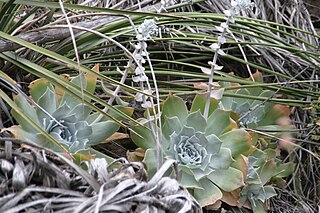
Dudleya pulverulenta is a species of perennial succulent plant known by the common names chalk lettuce, chalk dudleya, and chalk liveforever. It is one of the largest Dudleya, with a silvery, waxy rosette that may greatly contrast with its habitat. It is also regarded as one of the most distinctive members of the Dudleya, with one of the most specialized inflorescences in the genus, adapted to hummingbird pollination through its red pendent flowers, the longest corolla, and the highest nectar output. Dudleya pulverulenta has the largest range of all Dudleya, over 1,000 kilometres (620 mi), being found from southern Monterey County in California to the Sierra de San Borja in southern Baja California. It is closely related to Dudleya arizonica, a smaller desert species that tends to lack the specialized floral traits, and Dudleya anthonyi, which differs in a few morphological traits and is restricted to the San Quintín Volcanic Field.

Dudleya variegata is a deciduous succulent plant in the family Crassulaceae known by the common names variegated liveforever, variegated dudleya or rarely San Diego Hasseanthus. A cryptic plant that survives part of the year dormant underground from starch reserves in a corm, after sufficient rainfall, leaves will emerge, soon giving way to small inflorescences with yellow star-shaped flowers. It is native to Baja California and adjacent San Diego County in California, where it grows in several habitat types, including chaparral and vernal pools.

Dudleya attenuata is a species of perennial succulent plant known by the common name taper-tip liveforever, native to Baja California and a small portion of California. It is a rosette-forming leaf succulent which has narrow pencil-shaped leaves that can often be found covered in a white epicuticular wax. The thin, sprawling stems branch to form the clusters of rosettes, with plants creating a "clump" up to 40 cm wide. The small flowers are white or yellow, with 5 spreading petals. It is a diverse, variable species that extends from the southernmost coast of San Diego County to an area slightly north of the Vizcaino Desert, hybridizing with many other species of Dudleya in its range. Some plants with white or pinkish flowers were referred to as Orcutt's liveforever, referring to a former subspecies split on the basis of the flower color.

Dudleya ingens is a species of perennial succulent plant in the family Crassulaceae commonly known as the rock liveforever or Baja liveforever. A relatively large member of the genus Dudleya, this species has long green succulent leaves, and in April to June is characterized by pale yellow to white pink-tinged flowers topping tall, reddish inflorescences. It has a stem clothed densely with old, leathery leaves, and the inflorescence may be nodding, with the floral branches bearing the flowers tending to unfurl like the fronds of a fern. It is similar in appearance to Dudleya brittonii, but differs in range and chromosome number. This species is endemic to the state of Baja California in Mexico, being found from Santo Tomás to the southern coast of the state.

Dudleya hendrixii is a species of succulent plant known by the common name Hendrix's liveforever. It is a rare endemic restricted to undisturbed habitat near in the vicinity of Punta Colonet, Baja California, Mexico. The species is a small succulent that grows from an underground stem, producing small flowers in late spring to early summer before becoming summer deciduous and dormant. It was discovered in late 2016 by researchers from San Diego State University and the University of California, Santa Cruz, and is named in honor of the late musician Jimi Hendrix.
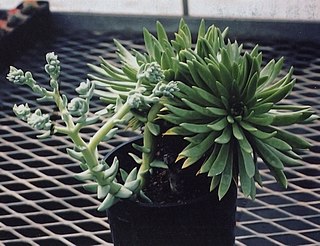
Dudleya guadalupensis is a very rare species of succulent perennial plant in the family Crassulaceae commonly known as the Guadalupe liveforever. It is a rosette-forming leaf succulent, with foliage that is variously colored light green, green, and a waxy white. It is characterized by dense leaves that fold over the center in dormancy, a curving, sinuous flower stalk, and white, cup-shaped flowers. It is endemic to the rocks and islets off of Guadalupe Island, an isolated volcanic island in the Pacific Ocean located 241 kilometers off of the coast of Baja California.

Dudleya pauciflora is a species of succulent plant in the stonecrop family known by the common name few-flower liveforever. It is characterized by its small crowded rosettes of narrow leaves and its colorful inflorescence with red-yellow flowers. Found growing on rocky outcrops and cliffs in the high elevation mountains of the Sierra de San Pedro Martir and the Sierra de San Borja, it is endemic to the state of Baja California, Mexico.

Dudleya campanulata is a species of perennial succulent plant known by the common name as the Punta Banda liveforever, native to Baja California and endemic to the Punta Banda peninsula, a promontory south of Ensenada that encloses the southern limit of the Bahía de Todos Santos, a deepwater bay. One of many species of Dudleya native to the peninsula and surrounding islands, it is distinguished by its campanulate flowers and its occupation of a narrow habitat that consists of ocean bluffs on the southern end of the Punta Banda, near the well-known blowhole La Bufadora.

Dudleya linearis is an insular succulent plant known by common name as the San Benitos liveforever. It is a rosette-forming perennial characterized by its long, flat green leaves on clustered heads and its yellow flowers. It is endemic to the western island of the Islas San Benito, a small Mexican archipelago in the Pacific Ocean west of Cedros Island. The limited population of the species is vulnerable, and has twice come close to extinction from introductions of grazing animals.
Dudleya formosa, known by the common name La Misión liveforever, is a species of perennial succulent plant endemic to the Guadalupe Valley in Baja California. It is characterized by bright green leaves, red floral stems, and pink flowers.

Dudleya cultrata is a species of perennial succulent in the family Crassulaceae commonly known as the knife-leaved liveforever or the maritime succulent liveforever. This species is characterized by oblong, narrow green leaves and flowers with pale yellow petals that bloom from April to June. Although similar to Dudleya ingens, this species is most often seen growing sympatric with the larger, wax-covered Dudleya anthonyi. It is native to Baja California, occurring on the coast from Punta Colonet and San Quintin to El Rosario.
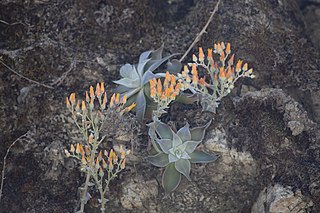
Dudleya cymosasubsp. pumila, most commonly known as the low canyon dudleya, chalky canyon dudleya or California live-forever, is a species of perennial succulent plant. It has diamond to spoon shaped leaves, sometimes coated with a fine white powder, and in May through July, bright red, orange or yellow flowers adorn the short inflorescence. A leaf succulent primarily found growing in rocky cliffs and slopes, it is endemic to California, and grows in the Transverse Ranges and South Coast Ranges, with some outlying populations. A variable plant, in some localities it is difficult to distinguish from other plants in the genus.
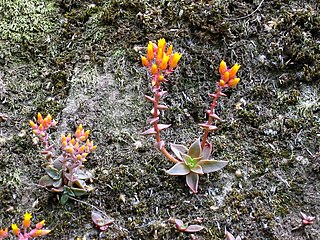
Dudleya cymosa subsp. marcescens is a species of summer-deciduous succulent plant known commonly as the marcescent dudleya or marcescent liveforever. Throughout the months of spring, it is characterized by a bloom of small, bright-yellow flowers with 5 petals, tinged with orange or red. It is a leaf succulent with a basal rosette, with the foliage withering in summer, going completely leafless, a neotenous trait in the genus. This species is endemic to the exposed volcanic rock of the Santa Monica Mountains in California, being found on shady slopes and outcroppings. It differs from its local congeners with its deciduous habit, slender caudex, and narrower leaf shape, although it is superseded in some of these characteristics by Dudleya parva, growing 13 km to the north, which has even narrower leaves and is quicker to lose them. Because of its restricted distribution and small size, it is vulnerable to habitat degradation and disturbance from acts of graffiti and rock climbers. It is listed as threatened by the United States Fish and Wildlife Service.

Dudleya cymosasubsp. agourensis, commonly known as the Agoura Hills dudleya or Agoura Hills liveforever, is a species of perennial succulent plant. A rare and critically imperiled species from the Santa Monica Mountains in California, it is characterized by glaucous, gray-purple leaves, bright yellow flowers, and ascending bracts. A leaf succulent, it is found growing on west to northwest-facing open, rocky volcanic slopes.


